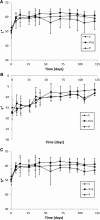Effect of olive leaf extract combined with Saccharomyces cerevisiae in the fermentation process of table olives
- PMID: 31205355
- PMCID: PMC6542927
- DOI: 10.1007/s13197-019-03782-x
Effect of olive leaf extract combined with Saccharomyces cerevisiae in the fermentation process of table olives
Abstract
Yeasts have a great importance in the table olives quality and have been proved more and more as starter cultures. Moreover, the addition of olive leaf extract (OLE) could enhance the nutritional value of table olives, but there are no studies in which added OLE has been combined with yeasts during fermentation. The aim of this work was to determine if the quality and functional value of table olives increases when OLE and a yeast starter are used during a Spanish-style olive fermentation process. Several combinations were used: (1) fermentations trials with OLE combined with a strain of Saccharomyces cerevisiae; (2) fermentations with OLE; (3) control fermentations, with no extract or starter culture. During fermentation performed with the addition of OLE and yeasts, the yeast number remained stable for most of the time, resulting in a slight decrease of yeasts by the end of the process. The phenolic profile of olive flesh and brines of the trials was analysed during the fermentation. The addition of OLE increased the concentration of phenols in olive flesh and brines at the end of the fermentation; in these fermentations, hydroxytyrosol was the most abundant, at around 1700 mg/kg in olive flesh and 3500 mg/L in brines olive flesh, whereas in the control fermentation the concentrations were around 900 mg/kg and 2500 mg/L, respectively. In spite of adding OLE, the fermentation resulted in olives without bitterness. We can conclude that yeast inoculation combined with OLE improves safety, nutritional value and other properties of the final product, without affecting its sensorial qualities.
Keywords: Fermented table olives; Food quality; Olive leaf extract (OLE); Phenolic compounds; Saccharomyces cerevisiae.
Conflict of interest statement
Conflict of interestThe authors declare they have no conflict of interest.
Figures



References
-
- Arroyo-López FN, Romero-Gil V, Bautista-Gallego J, Rodríguez-Gómez F, Jiménez-Díaz R, García-García P, Querol A, Garrido-Fernández A. Yeasts in table olive processing: desirable or spoilage microorganisms? Int J Food Microbiol. 2012;160(1):42–49. doi: 10.1016/j.ijfoodmicro.2012.08.003. - DOI - PubMed
-
- Bevilacqua S, Terlizzi A, Fraschetti S, Claudet J, Boero F. Taxonomic relatedness does not matter for species surrogacy in the assessment of community responses to environmental drivers. J Appl Ecol. 2012;49:357–366. doi: 10.1111/j.1365-2664.2011.02096.x. - DOI
-
- Cabrera-Bañegil M, Schaide T, Manzano R, Delgado-Adámez J, Durán-Merás I, Martín Vertedor D. Optimization and validation of a rapid liquid chromatography method for determination of the main polyphenolic compounds in table olives and in olive paste. Food Chem. 2017;233:164–173. doi: 10.1016/j.foodchem.2017.04.052. - DOI - PubMed
LinkOut - more resources
Full Text Sources
Other Literature Sources
